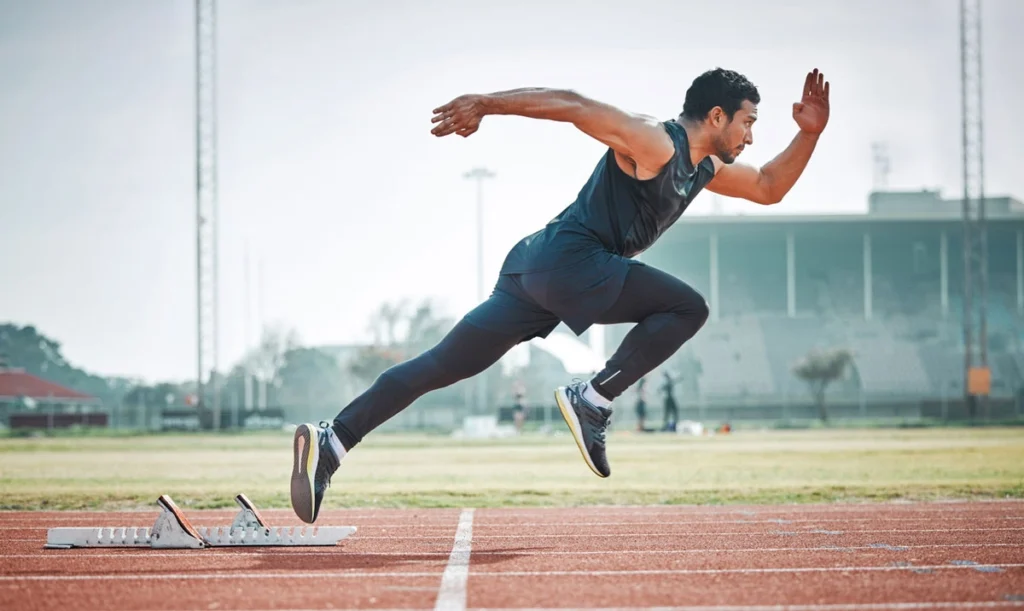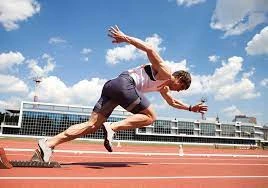Have you ever watched a track and field event and marveled at the explosive speed of the sprinters? There’s a raw power and grace in sprinting that is captivating. Whether you’re an athlete looking to gain a competitive edge, or someone who simply wants to improve their personal fitness, learning how to get quicker at sprinting is an achievable goal. It’s not just about running hard; it’s about running smart.
Unlocking your top speed involves a combination of refining your technique, building specific strength, and allowing your body to recover properly. This guide will provide you with a comprehensive roadmap, breaking down the essential components you need to focus on. We’ll cover everything from the mechanics of a good sprint to the drills and exercises that will help you learn how to get faster at sprinting quickly.
Table of Contents
The Foundation: Understanding Sprinting Mechanics
Before you can get quicker, you need to understand what makes a sprinter fast. Sprinting is a full-body effort that requires coordination, power, and efficiency. It’s more than just moving your legs quickly; it involves a powerful start, a rapid acceleration phase, and maintaining top speed for as long as possible. Each part of your body, from your feet to your fingertips, plays a role.
Proper form ensures that all the force you generate propels you forward with minimal wasted energy. This means maintaining a tall posture, using your arms to drive momentum, and having an efficient foot strike. Many aspiring sprinters make the mistake of focusing only on leg strength, but a strong core and coordinated upper body are just as crucial. Understanding these fundamentals is the first step in your journey toward becoming a faster, more efficient sprinter.
The Importance of Proper Form
Your running form is the blueprint for your speed. An inefficient technique can hold you back, no matter how strong you are. The goal is to create a smooth, powerful motion that maximizes forward propulsion.
Here are the key elements of proper sprinting form:
- Tall Posture: Run with your head, shoulders, hips, and feet aligned. Avoid leaning too far forward or backward. Your head should be in a neutral position, looking straight ahead.
- Relaxed Upper Body: Tension in your shoulders and neck wastes energy. Keep your shoulders down and relaxed, and let your arms swing freely from the shoulder.
- Powerful Arm Swing: Your arms counterbalance your legs and drive momentum. Bend your elbows at roughly a 90-degree angle and swing them forward and back, not across your body. Your hands should travel from your hip to your chin.
- High Knees: Drive your knees up powerfully with each stride. This helps increase your stride length and allows you to apply more force to the ground.
- Efficient Foot Strike: Land on the balls of your feet, directly underneath your center of gravity. Landing on your heels acts as a brake and slows you down. Aim for quick, light steps, minimizing ground contact time.

Strength Training for Explosive Speed
Sprinting is a power-based activity. To generate the explosive force needed to get quicker at sprinting, you must build strength in the right muscles. Your training should focus on developing power in your legs, glutes, and core. These muscle groups are the engine behind your speed.
A well-rounded strength program for sprinters includes compound lifts, plyometrics, and core-specific exercises. It’s not just about lifting heavy weights; it’s about training your muscles to contract quickly and forcefully. This type of training improves what’s known as reactive strength—the ability to absorb force and immediately repurpose it into explosive movement.
Essential Lower Body Exercises
Your lower body generates the primary force for sprinting. Focus on exercises that build strength and power in your posterior chain (glutes, hamstrings) and quads.
- Squats: A fundamental exercise for building overall leg strength. Variations like front squats and back squats are excellent for targeting different muscle groups.
- Deadlifts: Perfect for strengthening the entire posterior chain, which is critical for powerful hip extension during a sprint.
- Lunges: Unilateral exercises like lunges and split squats improve single-leg strength and stability, mimicking the motion of running.
- Nordic Hamstring Curls: This challenging exercise specifically targets the hamstrings, helping to prevent injuries and improve the power of your leg drive.
Plyometrics: The Key to Power
Plyometrics, or jump training, teaches your body to produce maximum force in minimum time. These exercises are crucial if you want to know how to get faster at sprinting quickly.
- Box Jumps: Jumping onto a box develops explosive power and improves your ability to generate vertical force.
- Broad Jumps: These focus on horizontal power, which is directly transferable to the acceleration phase of a sprint.
- Depth Jumps: Stepping off a box and immediately jumping up trains your body to absorb and redirect force efficiently.
- Bounding: Exaggerated running strides that focus on maximizing air time and distance per step.
Don’t Forget Your Core and Upper Body
A strong core acts as a stable base, allowing for the efficient transfer of power between your upper and lower body. A weak core can lead to poor posture and wasted energy.
- Planks: Build core stability and endurance.
- Weighted Pull-ups: Strengthen your lats and upper back, which contribute to a powerful arm swing.
- Lying Overhead Press: Improves your ability to generate upward momentum and maintain good posture.
Drills to Sharpen Your Technique and Speed
Drills are specific, repetitive movements designed to improve a particular aspect of your sprinting form. They help reinforce good habits and improve neuromuscular coordination—the communication between your brain and muscles. Incorporating drills into your warm-up is an effective way to prepare your body for a sprint session.
The Sprinting ABCs
These are foundational drills that break down the sprinting motion into its core components.
- A-Skips: A skipping motion with an emphasis on a high knee lift and a quick push-off. This drill improves coordination and reinforces a proper foot strike.
- B-Skips: Similar to an A-Skip, but you extend your leg forward at the top of the knee lift before snapping it back down. This helps with active leg recovery.
- C-Skips (Butt Kicks): Focus on pulling your heel quickly up toward your glute. This drill improves hamstring activation and stride frequency.

Drills for Acceleration and Top Speed
These drills target specific phases of the sprint.
- Wall Drills: Lean against a wall at a 45-degree angle and practice driving your knees up quickly. This isolates the leg drive motion used during acceleration.
- Hill Sprints: Running up a steep hill forces you into a good forward lean and requires a powerful leg drive, naturally improving your acceleration mechanics.
- Stride Drills (Wickets): Running over low hurdles or cones (wickets) spaced progressively closer encourages a faster foot turnover and shorter ground contact time.
Structuring Your Sprint Training Week
Consistency and balance are key. Your training schedule should include a mix of speed work, strength training, and adequate rest. Overtraining is a common mistake that can lead to injury and burnout. A good rule of thumb is to follow a 90/10 ratio of speed to endurance work.
Here is a sample training week:
| Day | Activity |
|---|---|
| Monday | Short-Speed Day (e.g., 6 x 40m sprints with full recovery) + Drills |
| Tuesday | Strength Training (Lower Body & Core) |
| Wednesday | Active Recovery (Light jog, stretching, foam rolling) |
| Thursday | Long-Speed Day (e.g., 4 x 200m sprints at 85% effort with 1:2 work-rest ratio) |
| Friday | Strength Training (Upper Body & Plyometrics) |
| Saturday | Active Recovery or Cross-Training (Swimming, Cycling) |
| Sunday | Rest |
Note: Full recovery between short sprints is crucial. A 1:10 work-to-rest ratio is recommended (e.g., a 6-second sprint requires 60 seconds of rest).
The Critical Role of Recovery and Nutrition
What you do off the track is just as important as what you do on it. Your muscles get stronger during recovery, not during the workout itself. Ignoring recovery can quickly undo all your hard work.
Sleep, Hydration, and Nutrition
- Sleep: Aim for 7-9 hours of quality sleep per night. This is when your body repairs muscle tissue and releases growth hormone.
- Hydration: Dehydration can severely impact performance. Drink water consistently throughout the day, not just during workouts.
- Nutrition: Fuel your body with a balanced diet.
- Carbohydrates: Provide the primary energy for high-intensity workouts.
- Protein: Essential for muscle repair and growth.
- Healthy Fats: Support overall health and hormone function.
Active Recovery Techniques
Active recovery helps reduce muscle soreness and improves blood flow.
- Foam Rolling: A form of self-massage that helps release muscle tightness.
- Stretching: Dynamic stretching before workouts and static stretching after can improve flexibility and range of motion.
- Light Activity: A gentle walk, jog, or swim on recovery days can promote circulation without stressing your muscles.
Common Mistakes to Avoid
Learning how to get quicker at sprinting also means knowing what not to do. Avoiding these common pitfalls will help you train more effectively and reduce your risk of injury.
- Overtraining: Doing too much, too soon. Your body needs time to adapt. Listen to its signals and prioritize rest.
- Improper Form: Focusing on effort over technique. Film yourself running or work with a coach to identify and correct form issues like overstriding or a poor arm swing.
- Ignoring Recovery: Thinking more is always better. Recovery is when you make gains. Skipping it leads to fatigue and injury.
- Neglecting Strength Training: Believing that sprinting alone is enough. Strength is the foundation of power and speed.
Conclusion
Becoming a faster sprinter is a journey that combines science, dedication, and smart training. By focusing on the key pillars—proper technique, targeted strength training, focused drills, and strategic recovery—you can unlock significant gains in your speed. Remember to build your foundation with solid mechanics, develop explosive power in the weight room, and sharpen your skills with drills. Most importantly, listen to your body and give it the fuel and rest it needs to perform at its best. With patience and consistent effort, you’ll be well on your way to leaving your old personal bests in the dust.
Key Takeaways
- Form is Paramount: A tall posture, powerful arm swing, and foot strike on the balls of your feet are essential for efficiency.
- Build Explosive Strength: Incorporate squats, deadlifts, and plyometrics to develop the power needed for speed.
- Drills Refine Technique: Use the sprinting ABCs, hill sprints, and wicket drills to improve your mechanics.
- Train Smart: Balance high-intensity sprint sessions with adequate rest and recovery. A typical split involves one short-speed and one long-speed day per week.
- Recovery is Non-Negotiable: Prioritize sleep, nutrition, and active recovery techniques like foam rolling to allow your body to adapt and get stronger.
- Avoid Common Pitfalls: Don’t overtrain, neglect strength work, or ignore the importance of proper form and recovery.
Frequently Asked Questions (FAQ)
Q1: How long does it take to get faster at sprinting?
A1: Results vary depending on your starting fitness level, training consistency, and genetics. However, with a dedicated program, many people see noticeable improvements in their form and power within 4-6 weeks. Significant speed gains often take several months of consistent training.
Q2: Can I get faster by just sprinting more?
A2: While practice is important, simply sprinting more without focusing on technique and strength can lead to plateaus and injuries. A comprehensive approach that includes strength training, drills, and proper recovery is the most effective way to learn how to get quicker at sprinting.
Q3: Is it better to have a longer stride or a faster stride frequency?
A3: The ideal is a balance of both. Overstriding (reaching too far with your front leg) can act as a brake. The goal is to have a powerful stride that covers a good distance combined with a quick turnover (frequency). Your optimal balance will depend on your individual biomechanics.
Q4: Do I need special shoes for sprint training?
A4: For general training and drills, good running shoes are sufficient. If you start training seriously on a track, investing in a pair of sprint spikes is highly recommended. Spikes provide superior traction, allowing you to apply more force to the ground.

Leave a Reply